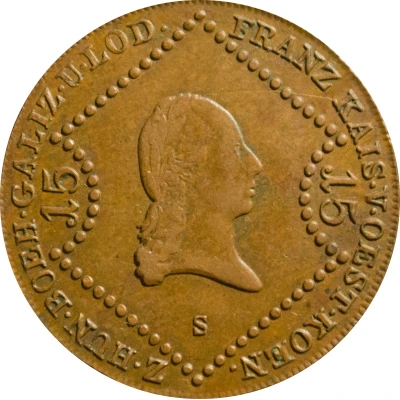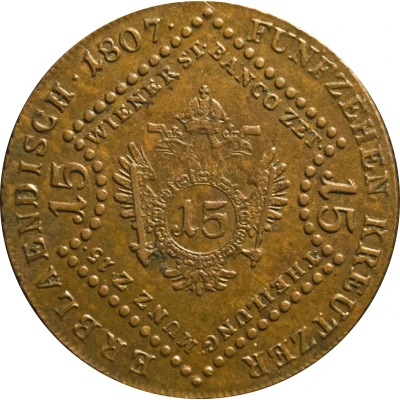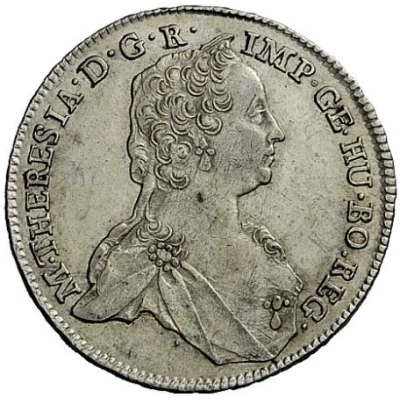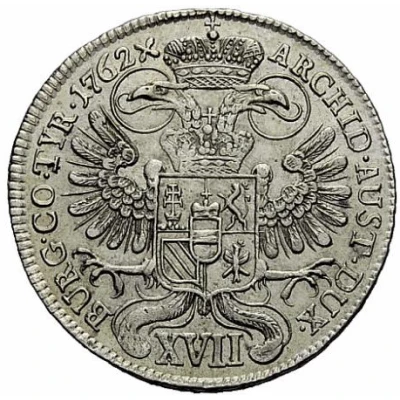


© Fritz Rudolf Künker GmbH & Co. KG, Osnabrück and Lübke & Wiedemann KG, Leonberg
15 Kreuzers - Francis I Pattern
1807 year| Silver | 21.29 g | - |
| Issuer | Austrian Empire |
|---|---|
| Emperor | Francis I of Austria (1804-1835) |
| Type | Pattern |
| Year | 1807 |
| Value | 15 Kreuzer (¼) |
| Currency | Gulden (1754-1857) |
| Composition | Silver |
| Weight | 21.29 g |
| Shape | Round |
| Technique | Milled |
| Orientation | Medal alignment ↑↑ |
| Demonetized | Yes |
| Updated | 2024-10-04 |
| Numista | N#313981 |
|---|---|
| Rarity index | 94% |
Reverse
Crowned double-headed eagle holding sword in right claw and sceptre in left claw. Round cartouche with value on its chest. Crown and ribbon above. Dotted frame around.
Script: Latin
Lettering:
FUNFZEHEN KREUTZER ERBLAENDISCH · 1807 ·
WIENER ST · BANCO ZET · THEILUNG · MUNZ Z · 15 ·
15
Unabridged legend: Fünfzehen Kreutzer erblaendisch. Wiener-Stadt-Banco-Zettel theilung Münze zu 15.
Translation: Fifteen Kreutzer [of the] hereditary lands. 15 [Kreutzer] fractional coin of the Vienna City Bank note.
Edge
Reeded
Comment
Stadtbanco, founded in 1727, was a municipal bank in Vienna that issued paper money called since 1762. To gain public confidence in the notes, the state accepted the paper money for tax payments and even offered the possibility of exchanging the Bancozettel for binding bank bonds. With the massive deterioration of the Austrian economy towards the end of the 18th century, the state issued an unreasonable quantity of new banknotes, that eventually lost their value. For reference, in 1793, the circulating Bancozettel amounted to 26.7 million guilders. By 1798, the value increased to 91.9 million guilders, in 1806 to 250 million guilders, and finally, in 1811, to more than one billion guilders. At the same time, the value of copper, silver, and gold coins rose. The court decree of 20 March 1807, determined the issue of 15 and 30 kreutzer coins in copper, although these denominations had always been silver before. The inscription makes clear that these coins were intended to be fractional coins of the Vienna Stadtbanco Bancozettel. A few specimens were made in silver, presumably as presentation pieces for high-ranking officials.This piece is one of the rarest Austrian coins of Emperor Francis I. One example was the most expensive coin in the Horsky Collection auctioned for 225 marks in 1967.
Interesting fact
One interesting fact about the Pattern 15 Kreuzers - Francis I (Pattern) 1807 from Austrian Empire made of Silver weighing 21.29g is that it was minted during a time of great change and upheaval in Europe. The coin was issued in 1807, just a year before the Austrian Empire was formed, and it features a unique design that was only used for a short period of time. The coin's obverse features a portrait of Francis I, the first Emperor of Austria, while the reverse features a crowned eagle with the Austrian coat of arms. The coin's design was meant to symbolize the new empire's power and influence, but it was ultimately replaced by a different design in the following years. Despite its short-lived use, the Pattern 15 Kreuzers remains a valuable and sought-after collector's item among numismatists today.



